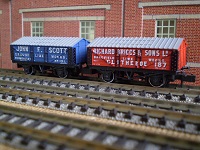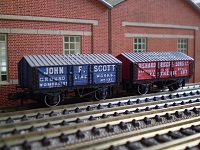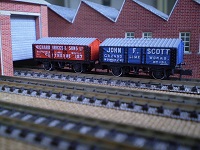Railways came into being in the heyday of the Industrial Revolution in order to transport goods quickly
and efficiently from the producer to the consumer, and once the inventive geniuses of the era had harnessed
the power of steam and put it on rails then the age-old dream of rapid transport became a reality. The main
product which those early railways carried was coal, borne along the iron road from pit to hearth in lumbering
wooden trucks, and the coal wagons of a century or more later would still look much the same. Being open to the
elements in transit isn't really much of a problem with coal, of course, but some other materials need rather
more in the way of protection if they're going to make it to their destination in decent condition. One of
these is lime, which comes out of the limekilns in the form of a gritty powder which reacts fiercely with
water. The hessian sacks which passed in those days for state-of-the-art packaging wouldn't have given much
protection from the rain, so the lime wagons had to be covered up to protect the load. In the early days they
would just have had a tarpaulin sheet draped over a central bar, but this was never a very satisfactory
arrangement, and by the time of the steam railway's Edwardian heyday the majority of lime producers were
shipping their produce in the pitched-roof wagons which became synonymous with the industry. These would
have been a familiar sight pretty much everywhere on Britain's vast railway network, with the agricultural
and construction industries ordering their lime from whoever was offering the best deal that week. The two
firms of Briggs and Scott were amongst the biggest suppliers in the North of England, and they would both
have had plenty of customers on either side of the Pennines. Bring a new consignment of lime to the farmers
and builders on your layout with our Lime Set.
Please note that these wagons are boxed individually.
|









